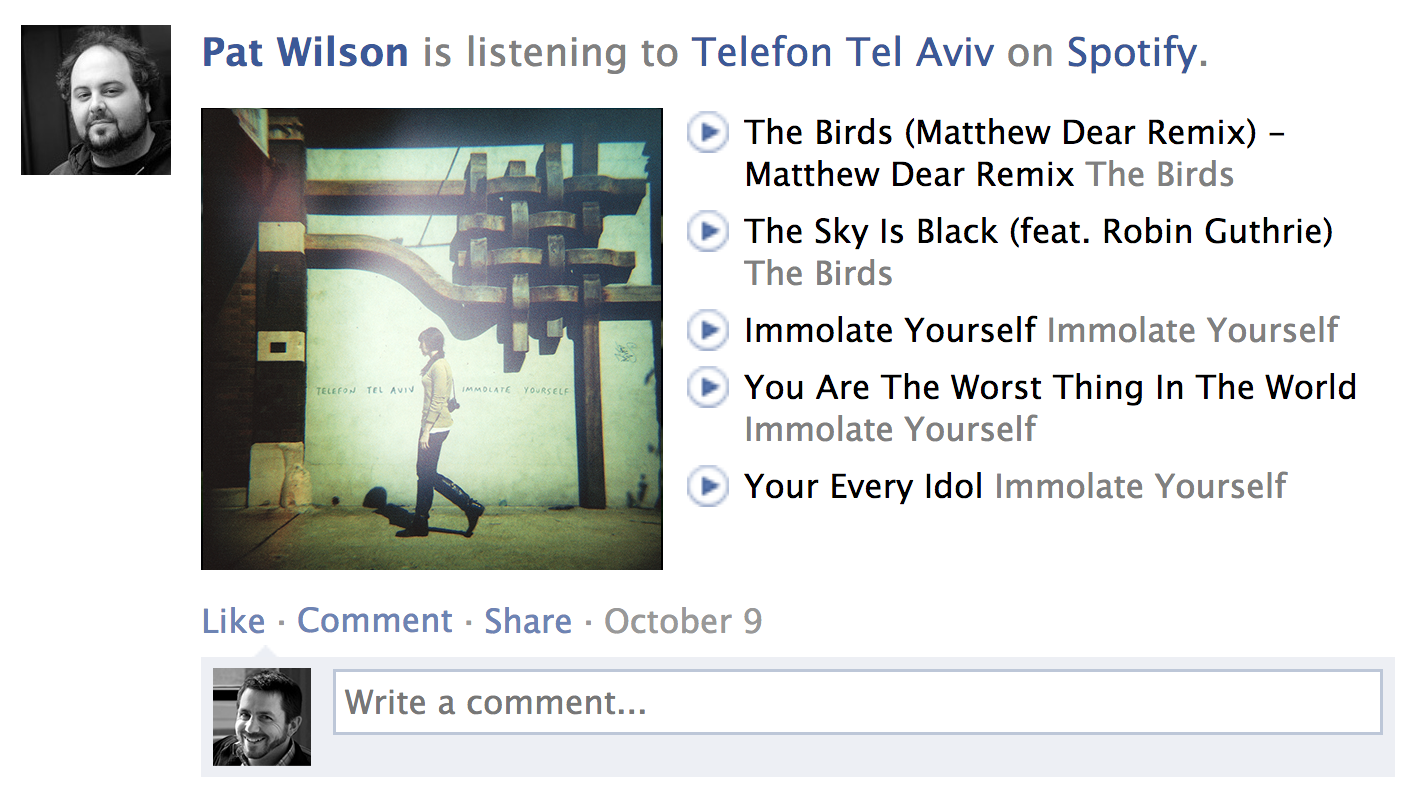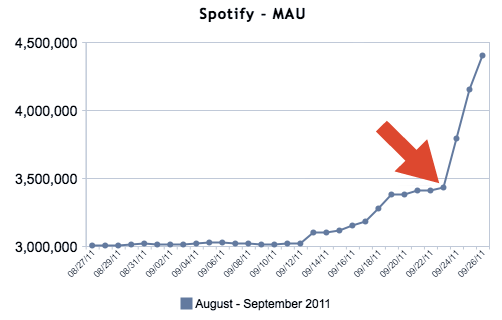
I am not hip or fashionable. I’m not on top of what the cool kids are doing. So, when Spotify launched in the UK in 2008, I wasn’t invited to the party. When they rolled out in the US in 2011, I didn’t even get a postcard. In fact, I didn’t find out about it until my friends started using it.
Like pregnancies and engagement announcements, I found out about Spotify on Facebook.
In the 2 years since that launch, Spotify posts have become a familiar sight on Facebook. Posts like this:

Some people love these posts; some people don’t care. Like any advertising, it only works on people who are interested. But unlike a banner ad, it doesn’t feel like an ad, it’s just a simple story about what my friend is doing: “Pat is listening to…”
We are used to people sharing links to Facebook. Sharing a link spreads a single piece of content. With these Spotify stories users are sharing how they consume the content.

This is a great advertisement for the app, as Pat’s friend I just learned about an app and how I would use it.
The results for Spotify were staggering. In the days after they rolled this out to Facebook, they added over a million daily active users.
The shift to sharing actions
Spotify uses Facebook’s Open Graph to share what their users listen to. The format of these stories shifts the focus from “here is a piece of content” to “this is what your friend is doing.”
It’s a subtle change, but it’s a stronger story. Just by adding a verb, the story becomes personal and contextual. Spotify’s action verb is “listen.”
For a user that has never heard of Spotify, the verb is informative. It helps connect the app’s name with the activity performed in the app.
Compare the following hypothetical sharing strategies:
- Pat invited you to try Spotify.
- Pat shared the song, “Hey Jude by The Beatles” via Spotify.
- Pat listened to a song on Spotify: “Hey Jude by The Beatles.”
Option 1: Lacks context that explains what Spotify is. Why should I use it? Is it something to identify laundry stains? I don’t need that right now, so I’m just going to ignore that one.
Option 2: This is better, but it draws attention to the song. I learn that my friend likes “Hey Jude.” The song gets the focus and the app is incidental. If I even notice the name of the app, I might think it’s just another site for sharing links.
Option 3: This tells the whole story. It’s brief, but it gives enough context for me to understand the purpose of the app. I can quickly deduce that the app is for listening to music, because that is what my friend is using it for.
Content + Activity = Context

As simple as it is, that verb is a powerful branding tool. It frames the context in which the piece of content is shared.
The short story “Pat listened to a song on Spotify” contains enough information to plant the following ideas in my head:
- Spotify is for listening to music.
- My friend uses it.
- I can listen to music on Spotify too, just by clicking on that story.
At a glance, I’d been educated with everything I needed to know. Not only do I know what the app does, but I also have social confirmation that my friend thinks it’s cool.
It’s brilliant advertising and it doesn’t feel like advertising. My friend is just doing what he does and I’m learning about the app he is using. It’s word of mouth advertising without a word spoken.
When you see a logo on your friend’s shoes you know the brand they like without having to ask. When you see an app in your friend’s Facebook activity, you learn about an app that they enjoy. This is friend to friend marketing.
As I saw more and more of these posts from my friends, I eventually tried the app out. Turns out it’s great a great app for listening to music. The strategy worked: my friends taught me about a service that I wouldn’t have paid attention to otherwise and I became a Spotify user (along with the millions of others who found it the same way).
What do your users do?
That of course got me thinking, what stories should my apps share? What verbs describe the interesting actions in my app? Which actions will attract new users from my users’ friend base?
If you are an app developer, you are probably thinking the same thing. Open Graph stories are a great way to get the word out about what your app does.
Short stories about friends “listening to music” worked wonders for Spotify. What short stories do you want your users to share?
– Mark

